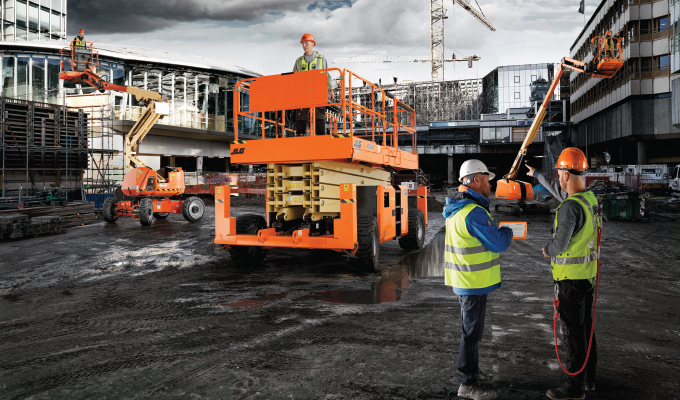Access control is an idea whose time has come. A growing number of fleet owners are recognizing that it’s a wise investment because it helps them create a safer jobsite and ensures that their machines are being operated properly.
This optional tool allows equipment owners to safeguard their machines and improve jobsite safety by preventing unauthorized personnel from accessing equipment. Using telematics, it enables remote management of users, machine lock-out, and access.
In the process, it helps to bring order to the chaotic environment of the jobsite.
“The typical construction site is not a neat, well-organized, perfectly-orchestrated place,” explains Ara Eckel, director of product management for JLG’s connected solutions platform team. “Machines and workers are moving everywhere, often on surfaces that are not level. That’s not an environment where you want untrained, unqualified operators utilizing aerial lifts.”
Most of the equipment on the jobsite is unsecured. If the keys are in it, anyone can use it. Untrained operators can not only put themselves and other workers in danger, but they also increase the odds of property or equipment damage.
SAFETY IS JOB ONE
Access control restricts the operation of aerial lift equipment to qualified and properly trained people. This list of approved operators can be remotely managed from a centralized web portal, enabling one person to manage hundreds of machines on multiple jobsites.
A list of authorized users is communicated to each machine in the field using telematics and is stored on its access control keypad. That means the system continues working, even if the machine is operating indoors or in areas with little or no cellular connectivity. Once it’s back in range of a cell tower or satellite, its database of authorized users is automatically updated.
IT’S IN THE CARDS
Machine operators receive a unique ID number or RFID card that allows them to access only the equipment they are authorized to operate via a keypad on the machine. The RFID cards, produced by the International Powered Access Federation (IPAF) and certain aerial lift manufacturers (including JLG) contain operator data, a list of machine models they’re qualified to operate and when each certification expires.
Access control can be managed via a PIN code, the RFID card, or both. Without proper authentication, the machine cannot be started or moved.
“RFID cards transform access control from a list of operator numbers and PIN codes into a knowledge system,” Eckel points out. JLG provides operator training and RFID cards loaded with the corresponding qualifications to its customers. That integrated approach helps fleet owners simplify operator administration.
In addition, the RFID cards enable fleet owners to track certifications that need to be renewed regularly. For example, OSHA considers telehandlers to be powered industrial trucks. It mandates that operators of them must be recertified every 3 years.
Other types of aerial lifts are governed by a voluntary set of ANSI standards, which specify that operators should be certified to operate them. Even though compliance isn’t mandatory, Eckel says that savvy fleet owners are recognizing that it makes sense from a safety and liability standpoint to align themselves with it.
EQUIPMENT UTILIZATION
Access control, in combination with telematics data collected from machines in the field, gives fleet managers a more complete picture of who is using each machine and how. A web-based portal provides them with up-to-date data on hundreds of machines in dozens of locations, all within one centralized interface. This gives them a more complete picture of machine utilization.
“Without access control, the machine’s telematics system reports when a machine is being used and where, along with basic condition data. But you can’t see who is operating it.” Eckel emphasizes. “Access control helps fleet managers to connect the dots by showing them who is operating each machine.”
That enables them to do a more effective job of managing machines and people—and ensuring jobsite safety in the process: “For example, if a daily inspection shows that an aerial lift was damaged, the access control system can tell you who the last person was who operated it,” Eckel points out. “And if it’s unsafe to operate, the fleet manager can send a lockout code to the machine that prevents anyone from using it until it’s repaired.”
FUTURE OF ACCESS CONTROL
To communicate with machines in the field, access control systems rely on the communications backbone offered by equipment telematics systems. The volume of data that can be transmitted is currently limited by communications bandwidth and the capabilities of today’s telematics hardware. As they evolve and improve in the coming years, they may enable many enhancements to access control.
“Currently, telematics systems report on basic equipment data; location, whether or not the machine is operating and a limited amount of conditional data, such as hour meter readings. Imagine if that could be expanded to include data on how a machine is being used,” envisions Rick Smith, senior director of global product training at JLG.
Soon, it may be possible to establish a profile of best operating practices and then compare that to the telematics data from each machine. That could provide key insights into the true level of proficiency of each operator.
“For example, are they attempting to move the machine without using the proper interlocks? Are they exceeding the machine’s maximum slope capabilities? Is the machine generating alarms that indicate they’re pushing the limits of the machine’s capacity when performing lifts?”
CLOSING THOUGHT
Smith adds that in many cases, this data is being captured on electronic control systems on the machine. They aren’t being reported by its telematics system—yet. But he’s confident that they will be as the technology improves. Once this detailed operating data becomes available, it may ignite a revolution in operator training.
About the Author:
Jennifer Stiansen is director of marketing with JLG. For more about ClearSky™ Access Control, part of JLG’s fleet management telematics solution, visit www.jlg.com.
Modern Contractor Solutions, January 2022
Did you enjoy this article?
Subscribe to the FREE Digital Edition of Modern Contractor Solutions magazine.



